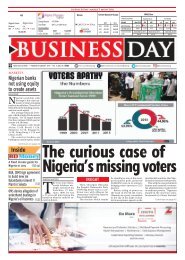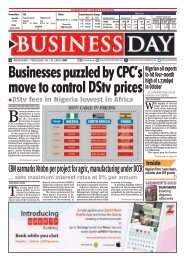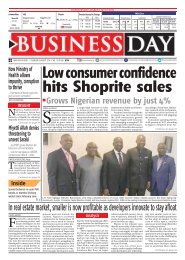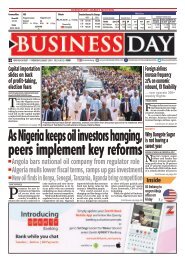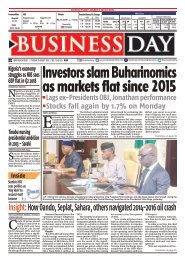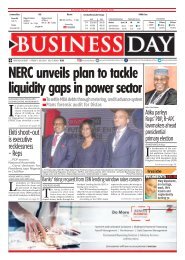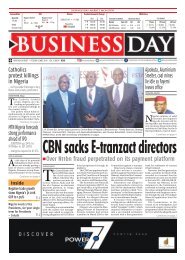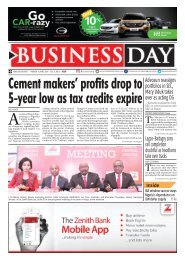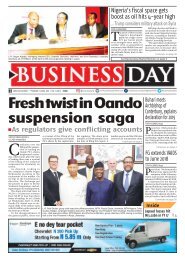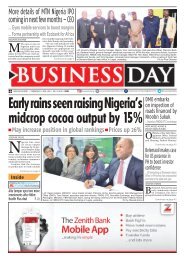BusinessDay 14 Dec 2017
Create successful ePaper yourself
Turn your PDF publications into a flip-book with our unique Google optimized e-Paper software.
A2 BUSINESS DAY<br />
C002D5556 Thursday <strong>14</strong> <strong>Dec</strong>ember <strong>2017</strong><br />
FT<br />
US economy faces a...<br />
NATIONAL NEWS<br />
ECB divisions on QE re-open after vintage year<br />
As the economy powers ahead, Mario Draghi will come under pressure over exit plans<br />
Claire Jones<br />
<strong>2017</strong> will go down as a vintage<br />
year for Mario Draghi.<br />
The eurozone economy is<br />
firing on all cylinders and<br />
the European Central Bank<br />
deftly handled an extension to its<br />
landmark bond-buying scheme.<br />
But 2018 could soon prove taxing<br />
for the ECB president as the<br />
pressure grows to end quantitative<br />
easing once and for all.<br />
With no major policy decisions<br />
imminent at their meeting in Frankfurt<br />
on Thursday, the last of the<br />
year, ECB policymakers will have a<br />
Continued from page A1<br />
the business environment, we would<br />
have seen capital inflows and an appreciating<br />
dollar.<br />
Of more importance is whether<br />
this growth is sustainable. From the<br />
supply side it is hard to imagine that<br />
an economy starting with 4.1 per cent<br />
unemployment can continue to create<br />
anything like 200,000 jobs a month<br />
when normal growth in the labour<br />
force is in the range of 60,000. From<br />
the demand side, this year’s growth<br />
was driven by a stock market rally that<br />
saw an increase of more than $6tn in<br />
household wealth. Even if the market<br />
holds its level, similar increases cannot<br />
be expected on a regular basis in<br />
the future.<br />
Such poor prospects for sustained<br />
rapid growth are not surprising given<br />
the economy’s weak foundation.<br />
Despite record low capital costs and<br />
abundant corporate cash — both<br />
inducements to investment — productivity<br />
growth has been very slow.<br />
Even innovative companies such as<br />
Apple and Google cannot find enough<br />
high-return investments and so choose<br />
to engage in large-scale share repurchases.<br />
Given record profits and low<br />
capital costs it seems more plausible<br />
to blame poor performance on insufficient<br />
public investment rather than<br />
inadequate incentives for private<br />
investment.<br />
This is a major issue. Given slow<br />
labour force growth, a substantial<br />
acceleration in productivity will be<br />
necessary to maintain the economy’s<br />
rate of expansion in coming years. Even<br />
if growth can be somehow maintained<br />
or accelerated, it is fundamental for<br />
a healthy economy that its benefits<br />
be widely shared. Unfortunately, the<br />
tendency has been very different in the<br />
US, where inequality has increased and<br />
much of the growth has been captured<br />
by a small share of the population.<br />
There will be no meaningful and<br />
sustained growth in workers takehome<br />
pay without successful measures<br />
both to raise productivity and to<br />
achieve greater equality. Only in this<br />
way can we achieve healthy growth.<br />
The tax-cut legislation now in<br />
committee on Capitol Hill exacerbates<br />
every important problem it claims to<br />
address, most importantly by leaving<br />
the federal government with an entirely<br />
inadequate revenue base. The<br />
bipartisan Simpson-Bowles budget<br />
commission concluded that the federal<br />
government needed a revenue base<br />
equal to 21 per cent of gross domestic<br />
product. In contrast, the tax cut legislation<br />
now under consideration would<br />
leave the federal government with a<br />
revenue basis of 17 per cent of GDP — a<br />
difference that works out to $1tn a year<br />
within the budget window.<br />
chance to celebrate growth that has<br />
exceeded all but the most bullish<br />
expectations and a jobless rate that<br />
is now at its lowest level since before<br />
the financial crisis.<br />
A fresh set of economic forecasts<br />
are expected to show the region’s<br />
recovery powering ahead in 2018.<br />
“After years of stagnation, <strong>2017</strong><br />
has become a year that you would<br />
never want to see end,” said Carsten<br />
Brzeski, economist at ING-DiBa.<br />
“The eurozone has outperformed<br />
the US and the UK, without<br />
high inflation. It’s been the best year<br />
in ages. I would expect the council<br />
to be patting each other on the<br />
backs this week.”<br />
The strength of the region’s<br />
recovery, however, has reopened<br />
divisions within the council.<br />
The ECB unveiled a sweeping set<br />
of measures at its previous meeting<br />
in late October, and is not expected<br />
to announce any major changes as<br />
soon as this week.<br />
In October, it extended its<br />
landmark quantitative easing programme<br />
until at least September<br />
next year but cut in half the amount<br />
of bonds it intends to buy each<br />
month, from €60bn to €30bn.<br />
While there was strong support<br />
for that decision, several members<br />
of the council, including some from<br />
the ECB’s inner sanctum, have since<br />
objected to the ECB president’s<br />
assertion that the bank has no<br />
intention of ending QE for good in<br />
September.<br />
Bond purchases were, Mr Draghi<br />
said in October, “not going to stop<br />
suddenly” in the autumn of next<br />
year. Some influential council<br />
members, including Bundesbank<br />
president Jens Weidmann and ECB<br />
board member Benoît Cœuré, think<br />
otherwise and believe that the recovery<br />
is now strong enough to shut<br />
down the programme completely in<br />
September.<br />
What to watch for in the Fed’s final meeting of <strong>2017</strong><br />
Markets are primed for another quarter-point increase in US interest rates<br />
Sam Fleming<br />
With traders fully primed<br />
for an interest-rate increase<br />
at the Federal<br />
Reserve’s final meeting of the year,<br />
investors’ focus on Wednesday<br />
will be on Fed chair Janet Yellen’s<br />
signals about 2018 and 2019, and<br />
on the impact of Donald Trump’s<br />
tax cutting package on the outlook.<br />
Here are the key points to<br />
watch for when the Federal Open<br />
Market Committee’s decision is<br />
released at 2pm US Eastern time<br />
on Wednesday.<br />
The Fed’s statement<br />
Traders are pricing in a quarter-point<br />
increase in the Fed’s<br />
target range to 1.25-1.5 per cent,<br />
in what would be the third upward<br />
move in <strong>2017</strong>. Key questions<br />
are whether the Fed’s postmeeting<br />
statement notes any<br />
slight firming in recent inflation<br />
numbers and how it characterises<br />
America’s growth and employment<br />
performance.<br />
Crucially, if the Fed does go<br />
ahead and lift rates, are there set<br />
to be any dissents? Policymakers<br />
to watch are Neel Kashkari of<br />
Minneapolis and Charles Evans<br />
of Chicago. Both have been worried<br />
about America’s soft inflation<br />
readings.<br />
The forecasts<br />
With growth surpassing a 3<br />
per cent annual rate in recent<br />
quarters and tax cuts looming,<br />
upgrades to the Fed’s economic<br />
projections are likely.<br />
The median forecast from the<br />
Fed in September pointed to<br />
growth of 2.4 per cent this year<br />
and 2.1 per cent in 2018. Jay Powell,<br />
who will succeed Ms Yellen as<br />
Fed chair early next year, has suggested<br />
he expects growth of up to<br />
2.5 per cent this year and next.<br />
The jobs market has also been<br />
stronger than the Fed predicted<br />
back in September, with unemployment<br />
at just 4.1 per cent<br />
and tipped to fall further. The<br />
median Fed forecast during the<br />
last round of predictions was for<br />
unemployment of 4.3 per cent at<br />
the end of this year and 4.1 per<br />
cent next.<br />
Crucially, the market will<br />
be scouring the Fed’s interest<br />
rate outlook. The so-called dot<br />
plot of interest rate predictions<br />
suggested in September that<br />
there will be three quarter-point<br />
increases next year. Some Wall<br />
Street analysts predict that could<br />
be upgraded to four.<br />
Yellen’s parting shot<br />
Ms Yellen will give her final<br />
scheduled press conference<br />
starting at 2.30pm. She should<br />
be able to give an upbeat assessment<br />
of the economy she<br />
leaves behind, having presided<br />
over sharp declines in unemployment,<br />
steady growth and no<br />
market mishaps of note during<br />
her near-four-year term.<br />
Ms Yellen is likely to be<br />
quizzed on the Fed’s expectations<br />
for tax cuts and their potential<br />
impact on growth, as well as<br />
monetary policy. Investors want<br />
to know just how stimulative the<br />
Fed expects Republicans’ proposed<br />
tax reductions to be, and<br />
how much extra tightening it will<br />
pencil in as a response.<br />
Reporters are also likely to<br />
probe the debate swirling in<br />
Fed circles over the causes of<br />
subdued inflation and wage<br />
growth. Other key topics are the<br />
Fed’s response to effervescent<br />
financial markets, the sustainability<br />
of the recent acceleration<br />
in economic growth, and longerterm<br />
questions such as the best<br />
inflation target for the central<br />
bank to pursue.<br />
In the summer of 2015, finding<br />
an exit strategy from the ultraaggressive<br />
monetary support that<br />
the ECB has provided over the crisis<br />
years was dubbed “a high-class<br />
problem”.<br />
“We’re really far from that,” Mr<br />
Draghi said then. ECB watchers<br />
think that 2018 will be dominated<br />
by such a discussion, with dissenting<br />
voices growing louder from the<br />
spring onwards, should growth<br />
remain on track.<br />
The biggest concern will be that<br />
a mis-step in communications and<br />
spats within the ECB cause a market<br />
panic.<br />
ECB divisions on<br />
QE re-open after<br />
vintage year<br />
As the economy powers ahead, Mario Draghi<br />
will come under pressure over exit plans<br />
Claire Jones<br />
<strong>2017</strong> will go down as a vintage year<br />
for Mario Draghi. The eurozone<br />
economy is firing on all cylinders and<br />
the European Central Bank deftly handled<br />
an extension to its landmark bond-buying<br />
scheme.<br />
But 2018 could soon prove taxing for<br />
the ECB president as the pressure grows<br />
to end quantitative easing once and for all.<br />
With no major policy decisions imminent<br />
at their meeting in Frankfurt on<br />
Thursday, the last of the year, ECB policymakers<br />
will have a chance to celebrate<br />
growth that has exceeded all but the most<br />
bullish expectations and a jobless rate that<br />
is now at its lowest level since before the<br />
financial crisis.<br />
A fresh set of economic forecasts are<br />
expected to show the region’s recovery<br />
powering ahead in 2018.<br />
“After years of stagnation, <strong>2017</strong> has become<br />
a year that you would never want to<br />
see end,” said Carsten Brzeski, economist<br />
at ING-DiBa.<br />
“The eurozone has outperformed the<br />
US and the UK, without high inflation. It’s<br />
been the best year in ages. I would expect<br />
the council to be patting each other on the<br />
backs this week.”<br />
The strength of the region’s recovery,<br />
however, has reopened divisions within<br />
the council.<br />
The ECB unveiled a sweeping set of<br />
measures at its previous meeting in late<br />
October, and is not expected to announce<br />
any major changes as soon as this week.<br />
In October, it extended its landmark<br />
quantitative easing programme until at<br />
least September next year but cut in half<br />
the amount of bonds it intends to buy each<br />
month, from €60bn to €30bn.<br />
While there was strong support for<br />
that decision, several members of the<br />
council, including some from the ECB’s<br />
inner sanctum, have since objected to the<br />
ECB president’s assertion that the bank<br />
has no intention of ending QE for good<br />
in September.<br />
Bond purchases were, Mr Draghi said<br />
in October, “not going to stop suddenly” in<br />
the autumn of next year. Some influential<br />
council members, including Bundesbank<br />
president Jens Weidmann and ECB board<br />
member Benoît Cœuré, think otherwise<br />
and believe that the recovery is now strong<br />
enough to shut down the programme<br />
completely in September.<br />
In the summer of 2015, finding an exit<br />
strategy from the ultra-aggressive monetary<br />
support that the ECB has provided<br />
over the crisis years was dubbed “a highclass<br />
problem”.




